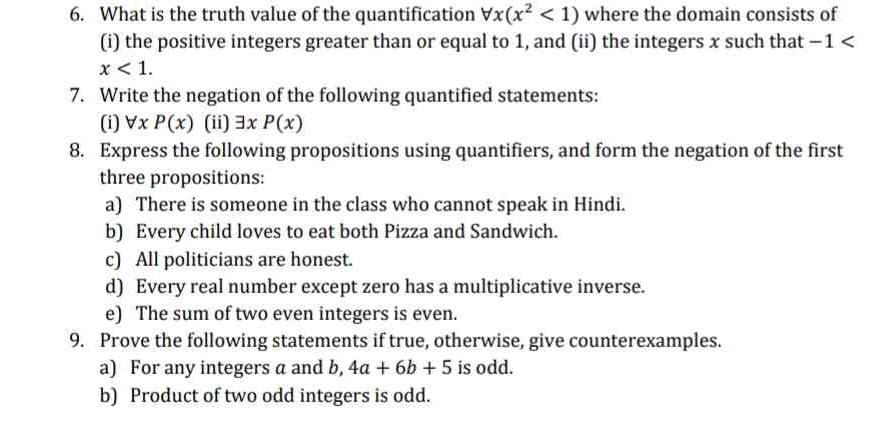What is the truth value of the quantification ∀x(x² < 1) where the domain consists of (i) the positive integers greater than or equal to 1, and (ii) the integers x such that -1 < x... What is the truth value of the quantification ∀x(x² < 1) where the domain consists of (i) the positive integers greater than or equal to 1, and (ii) the integers x such that -1 < x < 1? Write the negation of the following quantified statements: (i) ∀x P(x) (ii) ∃x P(x). Express the following propositions using quantifiers and form the negation of the first three propositions: (a) There is someone in the class who cannot speak in Hindi. (b) Every child loves to eat both Pizza and Sandwich. (c) All politicians are honest. (d) Every real number except zero has a multiplicative inverse. (e) The sum of two even integers is even. Prove the following statements if true; otherwise, give counterexamples: (a) For any integers a and b, 4a + 6b + 5 is odd. (b) Product of two odd integers is odd.

Understand the Problem
The question contains various mathematical problems related to quantification, propositions, and proofs. It asks for truth values, negation of statements, and expressions using quantifiers, followed by a proof for certain integer properties.
Answer
6. (i) False, (ii) True. 7. (i) $$ \exists x \neg P(x) $$ (ii) $$ \forall x \neg P(x) $$ 8. a) $$ \exists x \neg S(x) $$ b) $$ \forall x (C(x) \implies (P(x) \land S(x))) $$ c) $$ \forall x (P(x) \implies H(x)) $$ 9. a) True. b) True.
Answer for screen readers
-
(i) False, (ii) True.
-
(i) $$ \exists x \neg P(x) $$ (ii) $$ \forall x \neg P(x) $$
-
a) $$ \exists x \neg S(x) $$ b) $$ \forall x (C(x) \implies (P(x) \land S(x))) $$ c) $$ \forall x (P(x) \implies H(x)) $$
-
a) True. b) True.
Steps to Solve
-
Truth value of quantification for positive integers
For (i) the domain is positive integers ≥ 1. The expression $P(x): x^2 < 1$ is never true since $x^2$ for $x ≥ 1$ is always ≥ 1. Thus, the statement $\forall x (P(x))$ is false.
For (ii) with integers $x$ such that $-1 < x < 1$, the only values are $0$ and numbers between $-1$ and $1$. $P(x)$ is true for $x = 0$, making the expression $\exists x (P(x))$ true.
-
Negation of quantified statements
For (i) $\forall x P(x)$, the negation is
$$ \exists x \neg P(x) $$
It means there exists at least one $x$ for which $P(x)$ is false.
For (ii) $\exists x P(x)$, the negation is
$$ \forall x \neg P(x) $$
It means for every $x$, $P(x)$ is false.
-
Express propositions using quantifiers
a) "There is someone in the class who cannot speak Hindi"
$$ \exists x , \neg S(x) $$ where $S(x)$ means "$x$ can speak Hindi".
b) "Every child loves to eat both Pizza and Sandwich"
$$ \forall x (C(x) \implies (P(x) \land S(x))) $$ where $C(x)$ means "$x$ is a child", $P(x)$ is "loves Pizza", and $S(x)$ is "loves Sandwich".
c) "All politicians are honest"
$$ \forall x (P(x) \implies H(x)) $$ where $P(x)$ is "$x$ is a politician" and $H(x)$ is "$x$ is honest".
-
Negations of the first three propositions
a) The negation becomes
$$ \forall x , S(x) $$
b) Negation
$$ \exists x (C(x) \land (\neg P(x) \lor \neg S(x))) $$
c) Negation
$$ \exists x (P(x) \land \neg H(x)) $$
-
Proving statements or providing counterexamples
a) For $a, b \in \mathbb{Z}$, the statement "$4a + 6b + 5$ is odd.".
This is true since $4a$ and $6b$ are both even. Therefore, adding 5 (odd) gives an odd result.
b) The product of two odd integers is odd. For odd integers:
$$ x = 2m + 1 \quad \text{and} \quad y = 2n + 1 $$
Then $xy = (2m + 1)(2n + 1) = 4mn + 2m + 2n + 1$, which is odd.
-
(i) False, (ii) True.
-
(i) $$ \exists x \neg P(x) $$ (ii) $$ \forall x \neg P(x) $$
-
a) $$ \exists x \neg S(x) $$ b) $$ \forall x (C(x) \implies (P(x) \land S(x))) $$ c) $$ \forall x (P(x) \implies H(x)) $$
-
a) True. b) True.
More Information
These quantifications and logical expressions are foundational in mathematical logic and help in formalizing statements. Understanding both quantification and negation is crucial for constructing valid arguments or proofs.
Tips
- Misinterpreting the quantifiers, such as confusing "for all" with "there exists".
- Negating statements incorrectly, particularly with the logical operators.
- Not carefully distinguishing between even and odd integers during proofs.
AI-generated content may contain errors. Please verify critical information